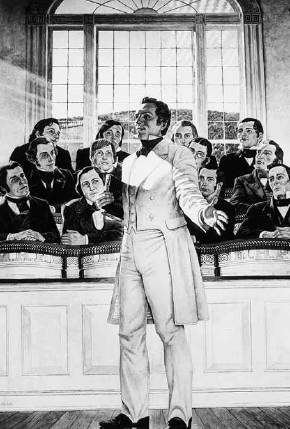 Origins Origins
In
1842, just two months after being initiated into Freemasonry,
Joseph Smith introduced the wearing of garments to a select
group of men. On Wednesday, May 4th, 1842, Joseph Smith
initiated nine men into his new inner-circle called the
"Holy Order," the "Quorum," the "Holy Order of the Holy
Priesthood," or the "Quorum of the Anointed." This ritual
would later come to be known as the LDS temple endowment.
Performed
in the upper story of Smith's Nauvoo store, this new ritual
was a significant departure from the simple feet washings
Joseph Smith taught in Kirtland. In addition to body washing
and anointings, these select men of Smith's "Quorum of
the Anointed" received garments.
The original garment was designed only for priesthood
men, after the pattern of mid-nineteenth century longjohns.
It was originally a one-piece garment made of plain, unbleached
cotton cloth that covered the body from ankles to wrists.
No buttons were used on the garment. Four to five tie-strings
took their place to hold the front closed.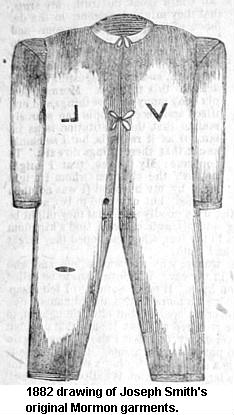 The garment had little collars which were not visible
from the outside of the shirt worn over it.
The garment had little collars which were not visible
from the outside of the shirt worn over it.
In
the crotch area was a large flap, which ran from the back
below the waist all the way under the body and met the
front tie closing. The flap was completely double so the
men had to pull it apart in order to expose themselves.
Ceremonial markings on the garment were originally snipped
into the cloth as part of the man's washing and anointing
ceremony. This helped keep the markings secret from those
who had not been through the ritual, including the women
who sewed the garments. These marks made during the endowment
were much more prominent than the marks in garments today.
Purpose
The
original purpose of wearing garments was to remind Smith's
priesthood brethren of their sacred oaths - especially
oaths of secrecy regarding
the plural marriage doctrine.
Today,
church leaders still describe garments in terms of "armor"
which has the primary purpose of reminding members of
their temple oaths:
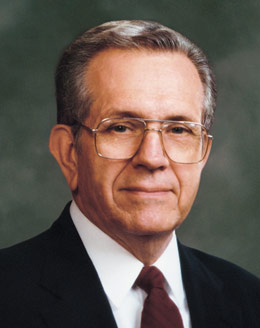 "The
garment, covering the body, is a visual and tactile
reminder of our covenants. It fosters modesty
and becomes a shield and protection to the wearer." "The
garment, covering the body, is a visual and tactile
reminder of our covenants. It fosters modesty
and becomes a shield and protection to the wearer."
"There
is, however, another piece of armor worthy of our consideration.
It is the special underclothing known as the temple
garment, or garment of the holy priesthood, worn by
members of The Church of Jesus Christ of Latter-day
Saints who have received their temple endowment. This
garment, worn day and night, serves three important
purposes; it is a reminder of the sacred covenants
made with the Lord in His holy house, a protective
covering for the body, and a symbol of the modesty of
dress and living that should characterize the lives
of all the humble followers of Christ."
- Apostle Boyd K. Packer, The Holy Temple, page
79, 75
Protection
Garments
were not originally believed to provide any physicial
protection. However, this idea came about by the circumstances
surrounding the deaths of Joseph and Hyrum Smith in the
jail at Carthage, Illinois. Neither Joseph,
Hyrum, nor John Taylor had been wearing their garments.
Willard Richards, who had been wearing his garments, escaped
unscathed in the attack.
In
Mormon folklore, garments have sometimes functioned as
a classic amulet that has power in itself independent
of the righteousness of the wearer: Mormons tell stories
of members in fires having all of their clothing burned
from their bodies except where their garments were. The
only burns suffered are on hands and feet, which are not
protected by the garments. However, such stories are not
endorsed by church leaders.
Making
the Garment
There
are conflicting accounts of how the first garments were
designed. According to one account, the original temple
garment was made of unbleached muslin with markings bound
in turkey red, fashioned by Nauvoo seamstress Elizabeth
Warren Allred under Joseph Smith's direction. Joseph's
reported intention was to have a one-piece garment covering
a man's arms, legs and torso, having "as few seams as
possible" (Munson n.d.; see also H. Kimball Diary,
21 Dec. 1845; Reid 1973, 169).
Another story circulated to temple workers in the late
19th century said:
"When
Joseph Smith received the endowments and revelation from
the Lord to be given to his people by authority, he also
received instructions as to how to make this garment.
None had ever seen anything like it and the sisters who
made it were under his direction and when it was submitted
to him, he said that it was right and the way it had looked
to him and he accepted it. This garment had a collar and
it had strings to tie it and sleeves that came to the
wrist, not to the hand, but about an inch above, and the
leg came down to the ankle joint. This was the pattern
given and it is right for Aunt Eliza Snow was the governess
and seamstress in his house at the time the first garments
were made and heard the instructions to the sisters."
- TEMPLE INSTRUCTIONS; Zina Y. Card; "Garments"
Male-only
Design
Because
women were not originally intended to be a part of the
endowment ceremony, when they were finally admitted, women
received the same garment as the men. Women and men in
the church wore the very same garments until 1965. Thus,
all Mormon pioneer women wore the men's garment, which
were 100% cotton longjohns.
As early as the 1890s, LDS women tried getting their own
garment pattern, but to no avail.
"Sister Zina D. H. Young submitted a knitted
garment something like our garments which is made in the
East and asked if such may be marked & have a collar put
on it and used as out Temple garment. It was decided by
the First Presidency that such garments should not be
used in lieu of the pattern given."
- L. John Nuttall Journal, Vol 3, p. 227; 8 December
1890
Church priesthood leaders made it very clear that there
was only one pattern for making and wearing garments and
they must never be altered:
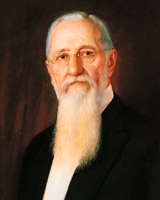 "Each
individual should be provided with the endowment clothing
they need. The garments must be clean and white, and of
the approved pattern; they must not be altered
or mutilated, and are to be worn as intended, down to
the wrist and ankles, and around the neck. These requirements
are imperative; admission to the Temple will
be refused to those who do not comply therewith." "Each
individual should be provided with the endowment clothing
they need. The garments must be clean and white, and of
the approved pattern; they must not be altered
or mutilated, and are to be worn as intended, down to
the wrist and ankles, and around the neck. These requirements
are imperative; admission to the Temple will
be refused to those who do not comply therewith."
- President Joseph F. Smith, "Instructions Concerning
Temple Ordinance Work," President of the Salt Lake Temple
1898-1911
Nevertheless,
at the turn of the 20th Century, more LDS women were altering
their garments for comfort. In response, temple president
Joseph F. Smith declared:
"The Lord has given unto us garments of the
holy priesthood, and you know what that means. And yet
there are those of us who mutilate them, in order that
we may follow the foolish, vain and indecent practices
of the world."
"In order that such people may imitate the fashions,
they will not hesitate to mutilate that which should be
held by them the most sacred of all things in
the world, next to their own virtue, next to their own
purity of life. They should hold these things that God
has given unto them sacred, unchanged and unaltered from
the very pattern in which God gave them. Let
us have the moral courage to stand against the opinions
of fashion, and especially where fashion compels us to
break a covenant and so commit a grievous sin."
- President Joseph F. Smith, "Fashion and the Violation
of Covenants and Duty," Improvement Era 9, August 1906,
812-815.
That same year (1906) church leaders had the following instructions
printed and displayed in the women's dressing area of all
church temples:
"The following is to be regarded as an established
and imperative rule. The garments worn by those who receive
endowments must be white and of the approved pattern;
they must not be altered or mutilated, and are to be worn
as intended, down to the wrist and ankles and around the
neck. Admission to the temple will be refused to those
who do not comply to these requirements."
"The Saints should know that the pattern of endowment
garments was revealed from Heaven and that the
blessings promised in connection with wearing them will
not be realized if any unauthorized change is made in
their form or in the manner of wearing them."
- Messages of the First Presidency 5:110; President
Joseph F. Smith; 28 June 1906.
Ten years later in 1916, the Prophet instructed the women
of the church:
"The garments worn by those who receive endowments
must be white and of the approved pattern. They must not
be altered and mutilated and are to be worn as intended,
down to the wrist and ankle, and around the neck. Admission
to the temple will be refused those who do not comply
with these requirements. The Saints should know
that the pattern of endowment garments was revealed from
heaven, and the blessings promised in connection
with wearing them will not be realized if any unauthorized
change is made in their form or in the manner of wearing
them."
- President of the Church, Joseph F. Smith, Improvement
Era 9:812, 28 June 1916
Garment
Changes
In April 1923 the First Presidency formed a committee
to investigate the origin of the garment and to recommend
"reconsiderations" in their pattern.
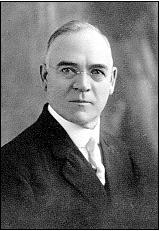 The
suggestion for the reconsideration apparently came because
of Salt Lake Temple President George B. Richards's questions
raised after a conversation with Sister Maria Dougall
in October 1922. At that time he learned that
Joseph Smith had not designed the garments and temple
clothing. The
suggestion for the reconsideration apparently came because
of Salt Lake Temple President George B. Richards's questions
raised after a conversation with Sister Maria Dougall
in October 1922. At that time he learned that
Joseph Smith had not designed the garments and temple
clothing.
In fact, a group of sisters led by Emma Smith and including
Bathsheba Smith had fashioned both the garments and the
temple clothing, and presented them to Joseph Smith for
his approval. The collar on the garments had been put
on because the sisters could think of no other way to
finish it at the top, and they added ties because they
had no buttons. The original cap in the temple clothing
had looked something like a crown, but Joseph Smith had
them redesign it to look more like a baker's cap.
- President George F. Richards Journal, October 11,
1922, April 5, 1923
On April 14, 1923, Temple President Richards discussed
the garment design with the First Presidency. At that
time, they considered such changes as removing the collar,
using buttons, and allowing women to use elbow-length
sleeves and shorter legs presumably to coordinate with
women's fashions, which had changed considerably by the
1920s. On May 17, 1923, the entire council and First Presidency
approved the new design.
- President George F. Richards Journal, April 14, May
17, 1923.
Here is that First Presidency Letter:
Heber J. Grant Letter Books; pp. 436, 437;
14 June 1923:
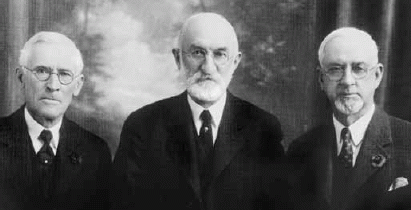 To
Presidents of Stakes and of Temples. To
Presidents of Stakes and of Temples.
Dear Brethren:
For some time past the First Presidency and Council of
Twelve have had under consideration the propriety of permitting
certain modification in the temple garment, with the following
result:
After careful and prayerful consideration it was unanimously
decided that the following modifications may be permitted,
and a garment of the following style be worn by those
Church members who wish to adopt it, namely:
(1) Sleeve to elbow.
(2) Leg just below knee.
(3) Buttons instead of strings.
(4) Collar eliminated.
(5) Crotch closed.
It may be observed that no fixed pattern of Temple
garment has ever been given, and that the present style
of garment differs very materially from that in use in
the early history of the Church, at which time
a garment without collar and with buttons was frequently
used.
It is the mind of the First Presidency and the Council
of Twelve that this modified garment may be used by those
who desire to adopt it, without violating any covenant
they make in the House of the Lord, and with a clear conscience,
so long as they keep the covenants which they have made
and remember that the garment is the emblem of the Holy
Priesthood designed by the Lord as a covering for the
body, and that it should be carefully preserved from mutilation
and unnecessary exposure, and be properly marked.
It should be clearly understood that this modified garment
does not supercede the approved garment now in use, that
either of these patterns may be worn, as Church members
prefer, without being considered unorthodox, and those
using either will not be out of harmony with the order
of the Church.
In order that there may be uniformity in temple work,
and that the expedition in the administration of the ordinances
of the House of the Lord may not be impeded, we recommend
that people doing temple work, whether it be ordinance
work for the dead or first endowments for the living,
wear the approved garment now in use. If persons appear
at the temple with the modified style, however, they should
not be refused admittance, provided they come properly
recommended. Bishops, in giving recommends to the temple
should call attention to this recommendation.
Will you advise the Bishops of your Stake of these changes,
being careful to give the matter no unnecessary publicity.
This letter is not to pass from your hands, nor are copies
to be furnished to any other person.
Your Brethren in the Gospel,
Heber J. Grant
Charles W. Penrose
A. W. Ivins
First Presidency.
The introduction of this new-style garment caused considerable
unrest among church members. As reported in the Salt Lake
Tribune in June 1923:
"In the old days the temple garment was made
of plain, unbleached cotton cloth. Unbleached linen was
as far afield in 'finery' as the devotee was permitted
to go. No buttons were used on the garment. Tape tie-strings
took their place. The garment itself was uncomfortably
large and baggy. But despite these imperfections, the
old-style garment is faithfully adhered to by many of
the older and sincerely devout members of the church.
These regard the garment as a safeguard against disease
and bodily harm, and they believe that to alter either
the texture of cloth or style, or to abandon the garment
altogether would bring evil upon them."
"One good woman of long membership in the church, hearing
of the change that has recently come about, went to the
church offices and uttered fervid objection. 'I shall
not alter my garments, even if President Grant has ordered
me to do so. My garments now are made as they were when
I was married in the endowment house long before the temple
was built. The pattern was revealed to the Prophet Joseph
and Brother Grant has no right to change it,' she said."
- The Salt Lake Tribune, "Temple Garments Greatly
Modified, Church Presidency Gives Permission, Style Change
Optional With Wearer"; Monday Morning, 4 June 1923
First
Design for Women
In
1965 for the first time, Mormon women received temple
garments modified for them. In a First Presidency letter
to all temple presidents, the presidency explained:
To PRESIDENTS of TEMPLES
Dear Brethren:
This will advise you that approval has been granted for
limited modification in the design of the garment used
in the temple to allow for better fit and greater wearing
comfort.
The approved modified design for women has a button front
rather than string ties, a brassiere top patterned after
the brassiere top of garments used for day-time wear,
a helanca stretch insert in the back at the waist, and
widened overlapping back panels with a helanca stretch
piece at the top of each panel and a button to assure
panels remaining closed. All other features of the garment,
including the collar, long legs, and long sleeves, remain
the same as heretofore.
The approved modified design of the garment for men has
a button front, closed crotch, helanca stretch insert
piece in the back at the waist, widened overlapping back
panels with a helanca stretch piece at the top of each
panel and a button to assure panels remaining closed.
All other features of the men's garment also, including
the collar, long legs and long sleeves, remain the same
as heretofore.
OFFICE OF THE FIRST PRESIDENCY
Salt Lake City 11, Utah
June 10, 1965
While these changes did lead to more comfort for womem,
some church members noted that the female garments were
still unattractive and contributed
to sexless or near sexless Mormon marriages.
Despite
these changes, the pre-1923 style garment was still required
in the temple ceremony until 1975 when its use
became optional. Occasionally, minor design changes have
been implemented such as lowering the neckline and shortening
the legs and sleeves.
Garments
are manufactured by the Church's Beehive Clothing Mills.
While members are not now permitted to make their own
garments, they may make their own temple clothing provided
it follows the approved design, although this is not openly
encouraged. Upon approval of the stake or mission president,
a handbook may be lent to worthy members who must make
the clothing under the supervision or direction of the
stake Relief Society president or mission president. One
additional recent policy change allows guests at temple
wedding ceremonies to attend in street clothes, provided
they have donned white slippers. Previously, all those
attending wedding ceremonies had to wear the full temple
clothing.
The most dramatic recent change was the two-piece garment
in 1979. In a letter to Church leaders dated December
15, 1979, the First Presidency announced the introduction
in February 1979 of two-piece temple garments. The new
style garments were offered in addition to and priced
about the same as the regular one-piece variety. No explanation
for or description of the new garments was given.
- Dialogue, Vol. 20, No. 4, p.56
Garments
have remained the same since the last changes in 1979,
although more women today are wearing their bras underneath
their garments. Traditionally, temple workers have told
women that they must wear the garment on their skin and
bras must be worn over the garment. Although some temple
workers continue to give this directive, there is no documented
instruction from the First Presidency to do so.
Even though women continue to suffer discomfort (especially
while menstruating) and a higher incident of yeast infections,
wearing garments as the church prescribes continues as
a fundamental practice of endowed women today.
Mormon
Garments in the Military
Some
time around 1999, the garment began to be released in
olive-drab green, for military members. The temple marks
were still embroidered on the outside of the garment,
and thus visible when troops worked in shirtsleeves. In
order to avoid public ridicule and embarrassment, most
military members during this era would wear two undershirts,
with the military garment worn underneath a civilian military
issue T-shirt.
Around this same time, individual military
services began to abandon the Army-controlled battle dress
uniform (BDU), which was to be worn with standarized OD-green
undershirts. As individual services began to produce their
own BDU, the array of undershirt colors expanded to include
black, desert tan, green, and many other variants.
With
increasing troop deployments to hot places like Iraq and
Afghanistan beginning around 2003, Gen Bruce Carlson,
Air Force Materiel Command, and highest ranking military
member of the LDS military affairs committee, communicated
to church leaders that deployed LDS military members were
inordinately suffering from heat-stress due to the double
undershirt issue.
In
response, around 2005-2006, Beehive clothing began to
produce desert-tan undergarments, with the marks silk-screened
on the inside of the shirt. These new garments with the
marks hidden on the inside elleviated the problem of members
having to wear double t-shirts.
As
of the winter of 2007, Beehive clothing also released
a desert tan cycling style lycra undershort, intended
to be worn during unit physical training exercises. The
new lycra form-fitting brief has also been released in
white, currently for women only. It is the most form-fitting
of the female undergarment bottoms. Beehive Clothing
also sent a memo around 2005-2006 to active-duty military
members, offering to custom silk-screen the marks on the
inside of other colored T-shirts for military and police
officers. Beehive Clothing requires proof of
military or police officer status to purchase these garments.
If
you have questions or comments, e-mail ldsgems@hotmail.com.
Next
>>: Mormon Garments,
A Relic of Polygamy
|